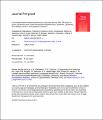| dc.contributor.author | Afanasenko, Anastasiia M. | |
| dc.contributor.author | Chulkova, Tatiana G. | |
| dc.contributor.author | Boyarskaya, Irina A. | |
| dc.contributor.author | Islamova, Regina M. | |
| dc.contributor.author | Legin, Anton A. | |
| dc.contributor.author | Keppler, Bernhard K. | |
| dc.contributor.author | Selivanov, Stanislav I. | |
| dc.contributor.author | Vereshchagin, Anatoly N. | |
| dc.contributor.author | Elinson, Michail N. | |
| dc.contributor.author | Haukka, Matti | |
| dc.date.accessioned | 2020-08-03T07:42:38Z | |
| dc.date.available | 2020-08-03T07:42:38Z | |
| dc.date.issued | 2020 | |
| dc.identifier.citation | Afanasenko, A. M., Chulkova, T. G., Boyarskaya, I. A., Islamova, R. M., Legin, A. A., Keppler, B. K., Selivanov, S. I., Vereshchagin, A. N., Elinson, M. N., & Haukka, M. (2020). C,N-chelated diaminocarbene platinum(II) complexes derived from 3,4-diaryl-1H-pyrrol-2,5-diimines and cis-dichlorobis(isonitrile)platinum(II): Synthesis, cytotoxicity, and catalytic activity in hydrosilylation reactions. <i>Journal of Organometallic Chemistry</i>, <i>923</i>, Article 121435. <a href="https://doi.org/10.1016/j.jorganchem.2020.121435" target="_blank">https://doi.org/10.1016/j.jorganchem.2020.121435</a> | |
| dc.identifier.other | CONVID_41655949 | |
| dc.identifier.uri | https://jyx.jyu.fi/handle/123456789/71314 | |
| dc.description.abstract | The reaction of 3,4-diaryl-1H-pyrrol-2,5-diimines with cis-dichlorobis(isonitrile)platinum(II) affords the C,N-chelated diaminocarbene platinum(II) complexes, which have been fully characterized including molecular spectroscopy, single crystal X-ray diffraction and DFT calculations. The obtained platinum(II) complexes are effective catalysts for the hydrosilylation of alkynes and alkenes. Thus, the reaction of phenylacetylene with triethoxysilane leads to the formation of α- and β-(E)-vinylsilanes, generating TON's in the range of 103 to 104 and TOF's in the range of 102 to 103 h−1. Also, the cross-linked silicones, possessing the luminescence properties, were obtained by the hydrosilylation reaction of vinyl- and hydride-containing polysiloxanes. Additionally, the efficiency of diaminocarbene platinum(II) complexes against CH1/PA-1, SW480, and A549 cancer cell lines has been demonstrated by in vitro cytotoxicity studies. | en |
| dc.format.mimetype | application/pdf | |
| dc.language | eng | |
| dc.language.iso | eng | |
| dc.publisher | Elsevier BV | |
| dc.relation.ispartofseries | Journal of Organometallic Chemistry | |
| dc.rights | CC BY-NC-ND 4.0 | |
| dc.subject.other | anti-cancer activity | |
| dc.subject.other | catalysis | |
| dc.subject.other | diaminocarbene platinum(II) complexes | |
| dc.subject.other | hydrosilylation | |
| dc.subject.other | luminescence | |
| dc.title | C,N-chelated diaminocarbene platinum(II) complexes derived from 3,4-diaryl-1H-pyrrol-2,5-diimines and cis-dichlorobis(isonitrile)platinum(II): Synthesis, cytotoxicity, and catalytic activity in hydrosilylation reactions | |
| dc.type | article | |
| dc.identifier.urn | URN:NBN:fi:jyu-202008035462 | |
| dc.contributor.laitos | Kemian laitos | fi |
| dc.contributor.laitos | Department of Chemistry | en |
| dc.contributor.oppiaine | Epäorgaaninen ja analyyttinen kemia | fi |
| dc.contributor.oppiaine | Inorganic and Analytical Chemistry | en |
| dc.type.uri | http://purl.org/eprint/type/JournalArticle | |
| dc.type.coar | http://purl.org/coar/resource_type/c_2df8fbb1 | |
| dc.description.reviewstatus | peerReviewed | |
| dc.relation.issn | 0022-328X | |
| dc.relation.volume | 923 | |
| dc.type.version | acceptedVersion | |
| dc.rights.copyright | © 2020 Elsevier B.V. All rights reserved. | |
| dc.rights.accesslevel | openAccess | fi |
| dc.format.content | fulltext | |
| dc.rights.url | https://creativecommons.org/licenses/by-nc-nd/4.0/ | |
| dc.relation.doi | 10.1016/j.jorganchem.2020.121435 | |
| jyx.fundinginformation | A part concerning to synthesis, photophysical properties, and catalytic activity of the ADC-platinum(II) complexes was supported by the Government of Saint Petersburg (grant N 4ntd-19 from November 15, 2019, T.G.C.). A part on photophysical properties of silicone rubbers was supported by the Russian Science Foundation (project 20-19-00256, R.M.I.). | |
| dc.type.okm | A1 | |

